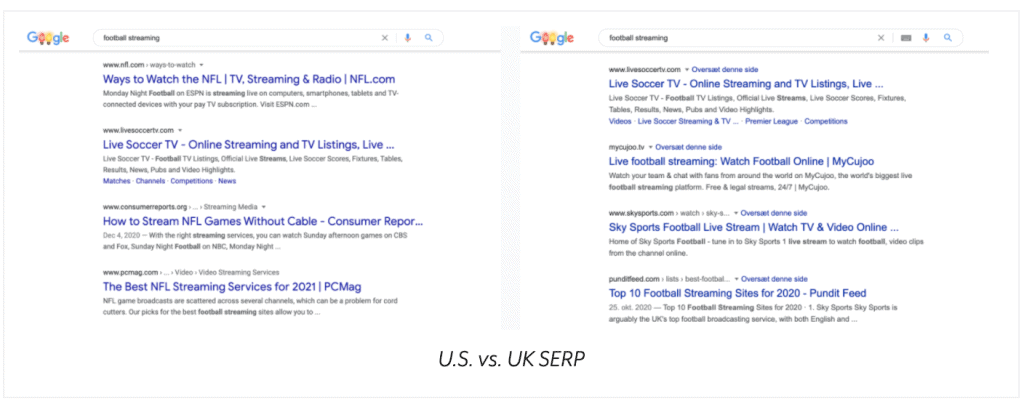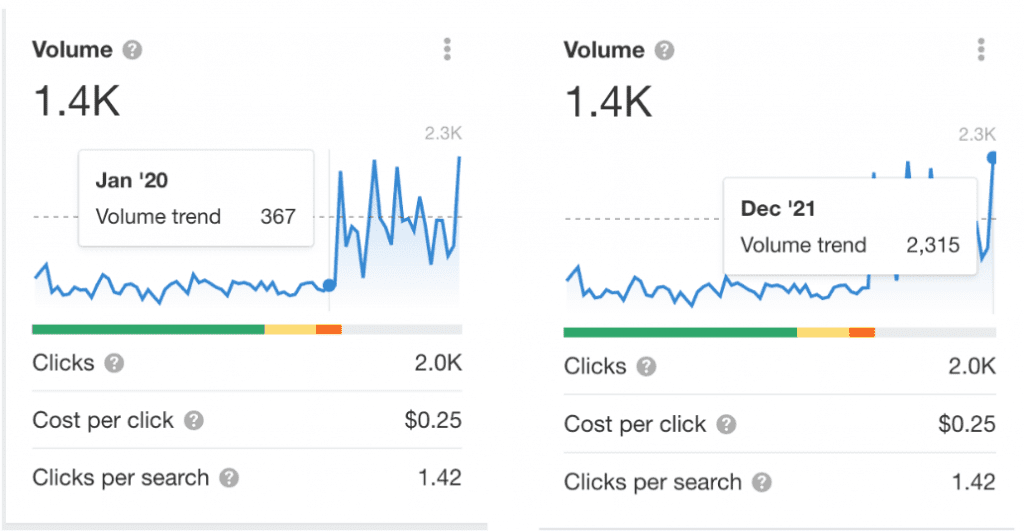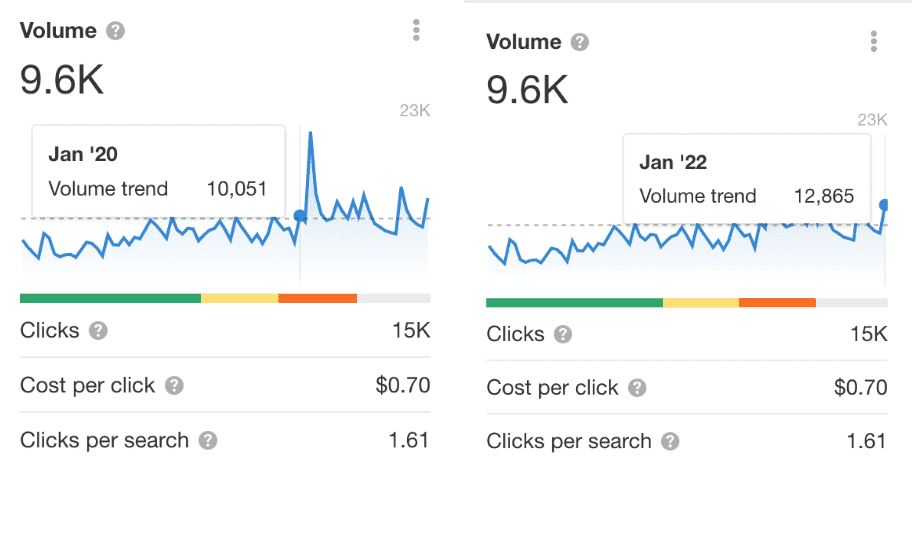/
SEO
/
0 min read
International SEO: 8-step guide to growing your international presence on Google

Author name and biographies in editorial content
Remove or rewrite content with low E-A-T
Build a personal brand
Optimize your site's technical health
Release user created content
If you want to succeed with international SEO - to go beyond Denmark's boarders on Google - you need the right strategy. Therefore, we've created this 8-step guide to international SEO. Read on and learn how to make your business more internationally visible on Google.
The pandemic has created new opportunities
The world changed drastically in 2020. The COVID-19 pandemic spread across the world and made consumers turn to online shopping and searches when looking for answers. Even though it created challenges for a lot of businesses, this increased digital consumer presence also created new opportunities – especially for businesses who wanted expand to new international markets. And this means that international SEO is becoming a focus point for more and more businesses.
A lot goes into creating a successful international SEO strategy: URL structure, page experience, the right content and keywords, competitor analyses on the global market, and much more.
So let's dive into our 8 step guide to international SEO.
Step 1: Hreflang from an international perspective
Hreflang is an HTML attribute that indicates the language of the content on your site. It also tells you the geographic location of the user. It can look like this:

The HTML tail "en-uk" is used to tell search engines like Google which language and geographic location you want your content to target. If you want to target a certain market or language, this is important to keep in mind.
Note: Hreflang does not work on search engines like Bing and Baidu, which both use content language meta data.

Therefore, you first need to decide which search engine you want to focus your international SEO strategy towards. Afterwards, you can go into depth with the technical optimizations of your site.
Step 2: Choose the right URL structure
In order to make your content reach your desired target group, you need to consider your site's URL structure. This consideration must be based on ccTLDs (country code top-level domains), subdomains, and subdirectories.
When you need to decide on the right URL structure for your site, you should do it based on how many resources you have available to succeed with the chosen URL structure. In a perfect world, you should choose the structure that we in Bonzer believe is the best: the TLDs structure, which allows you to have many different domains at the same time.
But if you have limited resources available for development and maintenance, you should not get involved with TLDs. In this case, the best structure is to work with subdomains. If neither the TLDs structure nor the subdomains structure works for you and your business, the last and also functional structure option is the subdirectories structure.
Step 3: Prepare page experience
Google's updates are more or less always focused on some sort of page experience.
Example: Core Web Vitals became a ranking factor in May 2021
Therefore, it's important that you keep an eye on your site's page experience when you execute your international SEO strategy.
One of the most important elements of page experience must be mobile-first index (also called mobile-only index). Mobile-first is a global issue and it's important to be prepared for it in all countries that your international strategy includes.
Step 4: Avoid machine translations
Even though it makes life easier and translations faster, you must be cautious with having your language variated websites translated by machines.
We've seen it many times: A company owner wants to target his business to more international markets and chooses to have his site translated with the use of a translation plug-in. And without fail, we see translation errors every time this happens. When you translate from one language to another, there will always be language nuances that a machine can't find. And a bad translation will not help your rankings on Google.
Therefore, use local translators (real people) who understand the importance of the original content as well as the context of what is being translated.
Step 5: Understand that keywords and SERPs vary from country to country
Even though the Google algorithm may be universal, the SERP (search engine result page) varies from country to country. If you search for a specific product in Sweden, you will in some cases experience a lot of different search results to what you would see if you searched for the same product in the US.
If you want to target your content towards a specific keywords in multiple countries, you should therefore start with analyzing the SERP in those countries. Be aware of local changes in search volume and the meaning of specific keyword. There will more or less never be the same number of searches on a keyword across countries. Therefore, keywords can have different meanings from country to country. For example, the keyword "SEO" is used in the same way globally, and the meaning of the word is the same across countries. But if you search for e.g. "football streaming" in the US, the results would be different to what you would get if you searched for the same keyword in the UK.

Remember that when you produce content that targets the same keywords across countries. Also, when deciding what content to produce and which countries to target, go for both high search volumes and relevant search intents.
Step 6: E-A-T has come to stay
E-A-T stands for "Expertise, Authoritativeness, and Trustworthiness." According to Google, content must live up to these three qualities to be trustworthy to users.
Some of the E-A-T-elements you should focus on:
Step 7: Don't just build links – build relations
Links are still important. And because links are based on the idea of references and recommendations, we believe that strong, relevant links will never disappear as a ranking factor.
Focus should be on quality, not quantity. This is due to the fact that a relevant link from a site with a domain rating below 50 and with only few outgoing links can contribute to better rankings compared to a lot of irrelevant links from sites with domain ratings below 50.
A good rule of thumb for getting strong, relevant links is to create relations with company owners and marketing people from your industry. Also, remember that when we're talking international SEO, links have different values depending on their origin. If your site e.g. receives a lot of links from URLs that end with '.de', this tells Google that your site is relevant for German people, and Google will therefore let your site rank on the German SERP. In other words, links in the respective languages you want your site to rank for will have the greatest impact on your rankings.
Step 8: Keep an eye on international and local search trends
With the emergence of COVID-19 in 2020, we saw a drastic shift in search volumes and consumer behavior. Although this happened across most of the world, search trends varied notably from country to country. If we take a look at the Danish keyword "hjemmearbejde" (working from home), the number of monthly searches in Denmark increased from 376 in January 2020 to 2315 in December 2021. This is an increase in search volume on 530.79% due to COVID-19.

If we take a look at the corresponding Swedish keyword to working from home ("jobba hemifrån"), we also see an increase in the number of monthly searches right before the COVID-19 pandemic began in January 2020 compared to January 2022. The increase is 28% – a smaller increase than we saw for the corresponding Danish keyword "hjemmearbejde."

However, the monthly search volume on "jobba hemifrån" increased significantly in March 2020 where the pandemic closed most of the Swedish society. Here, we see the monthly number of searches reach 23,000. That shows greater potential to rank for the Swedish "working from home" keyword than for the Danish one. It also shows that periods and months have a lot to say. These kinds of local search trends and fluctuations are always relevant to research and be aware of when prioritizing international SEO efforts.
Set your international SEO strategy alive
If you follow the 8 steps above, you're heading in the right direction towards a successful international SEO strategy. A final note is to remember to create an execution plan for your strategy. Divide your plan into the specific efforts needed on the technical front, for link building, and for content, and create a calendar with the efforts and the preparations needed for them.
If you're still not sure how to create a successful international SEO strategy, or if you're interested in a non-binding talk about you business' international SEO opportunities?

CPO & Partner
Thomas is the CPO (Chief Product Officer) and Partner at Bonzer, which means his day-to-day focus lies in constantly analyzing Google's algorithm and developing SEO as a product. Thomas has worked with SEO for several years with a strong passion for sharing his knowledge on how businesses can best implement SEO into their operations. In addition to Bonzer, Thomas contributes his expertise to readers at publications like Search Engine Journal, DanDomain, and Detailfolk. He also teaches Digital Media Strategy at Copenhagen Business School and SEO at DMJX in Copenhagen. If you have any questions or requests regarding the SEO universe, feel free to contact him at [email protected].

Let us show you an SEO strategy that can take you to the next level
A brief meeting, where we review your position in the market and present the opportunities.
Let us show you an SEO strategy that can take you to the next level
A brief meeting, where we review your position in the market and present the opportunities.